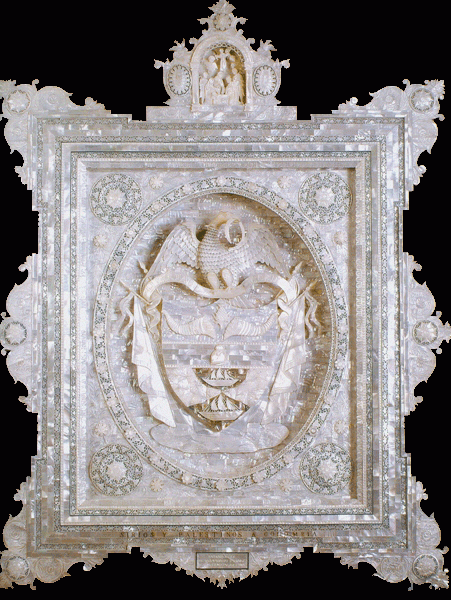Mother-of-pearl was traditionally a main handicraft in Bethlehem. It is believed that mother-of-pearl was introduced by Franciscan monks who came from Damascus to the Bethlehem area around the 15th century.With the presence of the order of St. Francis of Assisi in the Holy Land around the late 1600s, religious artifacts gained in economic importance. One Franciscan of the late sixteenth century, Father Bernard Amico, is well known for having made miniature reproductions of churches out of mother-of-pearl.  Since 1850, Bethlehem has witnessed a major development in the manufacture of mother-of-pearl, encouraged by the presence of pilgrims and religious persons who acquired them at a relatively good price due to the stability and increasing good relations between the Holy Land and Europe.The treasures of Crusader King Richard the Lion Heart included shells and mother of pearl items such as crosses and other religious objects. In 1220 some Christian leaders who were on a pilgrimage to the Holy Land brought back crosses and beads made of olive wood and of raw and simple shells.   The vaults of the Vatican include many boxes and cabinets that contain excellent mother-of-pearl works made by Palestinian artistic craftsmen in the Holy Land during the past three centuries. This craft has developed greatly during the 19th and 20th centuries. The role of craftsmen from Genoa and Damascus was well recognized historically, but during these two centuries Palestinians mastered this art and passed it on, mostly in the same clan or family, from one generation to the next.  Beautiful products include crosses, frames, boxes, models of religious monuments, and many other forms. In earlier times the raw material was brought by caravans from the Red Sea. Later on, one finds evidence of Bethlehemite traders purchasing this semi-precious material from New Zealand, Australia, Mexico, and Brazil. The entire production process is based on cutting, designing, gluing and polishing. This is carried out in local workshops mostly in the Bethlehem area.  Working with mother-of-pearl requires simple tools such as cutters. Certain chemicals are used to glue the mother-of-pearl pieces which are then polished not only to make them look better, but also to preserve them for a long time. The work is time-consuming and requires skill and patience. The introduction of modern tools in the second half of the 20th century, such as small motors and tools for carving, naturally made the work easier. Nowadays in workshops in Bethlehem, Beit Sahour, and Beit Jala one can see industrial tools that copy figures and carve them.    Most outstanding Palestinian artists in the field include Elias S. Dabdoub, Suleiman Dabdoub, whose work of the Dome of the Rock exists in the Top Kapi museum in Istanbul; Suleiman Roc (1831-1906), Hanna S. Rock (1863-1941), Yousef Jidi (1864-1934), Mikhael Lama, Butros Lama, Hanna Tabash, Elias Giacaman, Jamil Musallam, Saleh Abu Ayash, and others from the Salameh, Freij, Izmeri, Handal, Hazboun, Ballut, Shehadeh and Asfura families.     Hanna S. Rock, Butros I. Lama, Elias I. Giacaman , Saleh S. Abu Ayash The Zougbi family was well known for its skill in working on large models. Issa Mikhael Zougbi was a senior member of the community in Bethlehem; his sons, mainly Bishara (1863-1934) and Yousef (1878-1964) were well known artists in crafting creative mother-of-pearl items.   Jamil Musallam Gregory Zoughbi The legacy of the mother-of-pearl craft in the Bethlehem area continues to maintain the artistic vision and tradition of the Palestinian community. It has grown into a productive and lucrative industry providing some economic stability to the community of Bethlehem eventually attracting tourists and pilgrims who have valued the beauty and art of the mother-of-pearl craft to purchase them as gifts to take back home. |
  |
| Sources: | Daccarett, Enrique Yidi. El Arte Palestino De Tallar El Nacar. Colombia: Panamericana Formas e Impresos S.A. c. 2005. (source for photos used) |
| Zougbi, Saleem. “Mother of Pearl: A Traditional Palestinian Craft.” This Week In Palestine, no.109, May 2007. Based on the book, “Nacar di Palestina” by Enrique Jidi, Colombia | |
| Raheb, Mitri. Bethlehem 2000. Heidelberg: Palmyra Publishing House, c1998. | |
| Pixner, Bargil. The Glory of Bethlehem. Jerusalem: The Jerusalem Publishing House, Ltd., c1981. |


